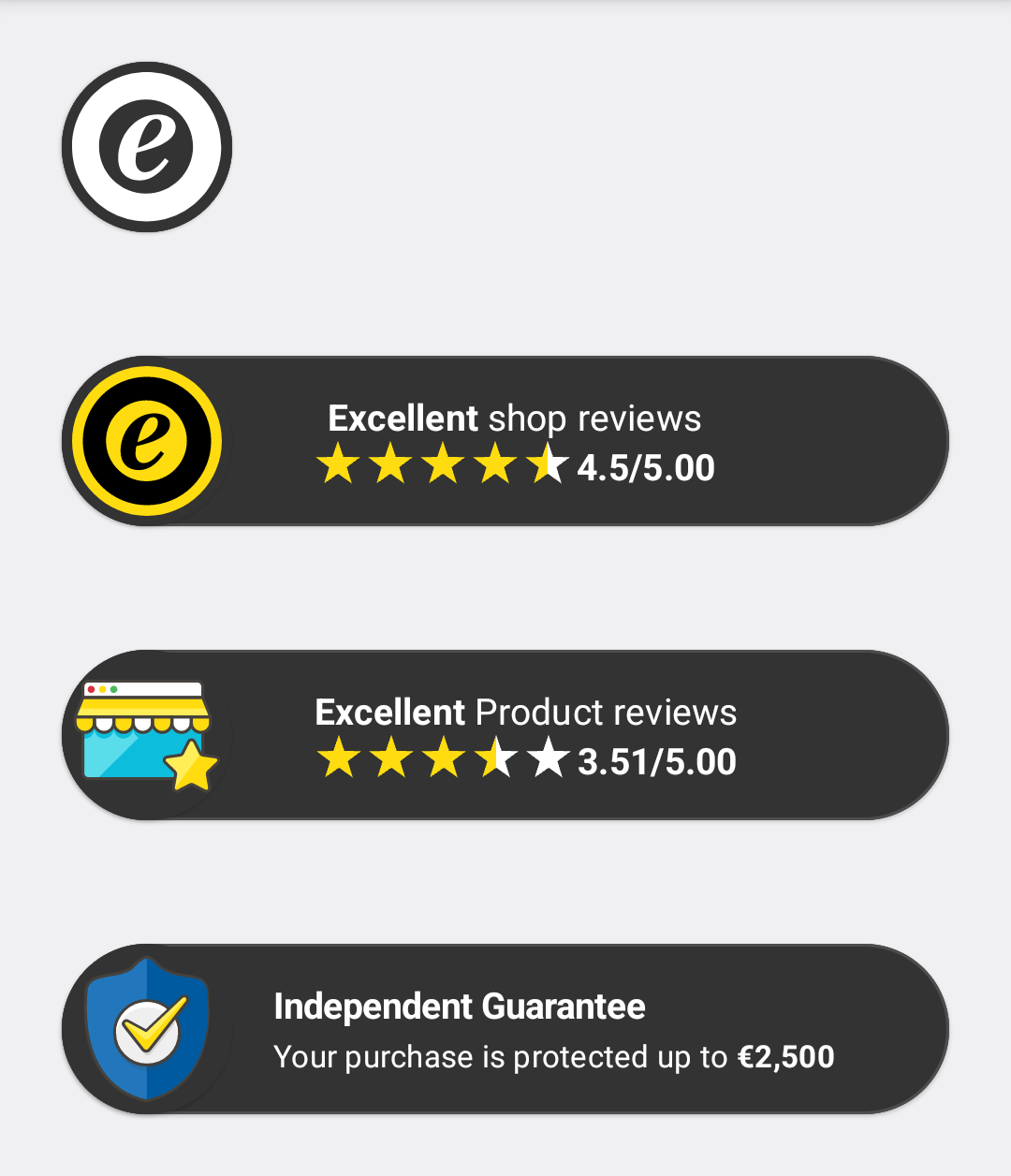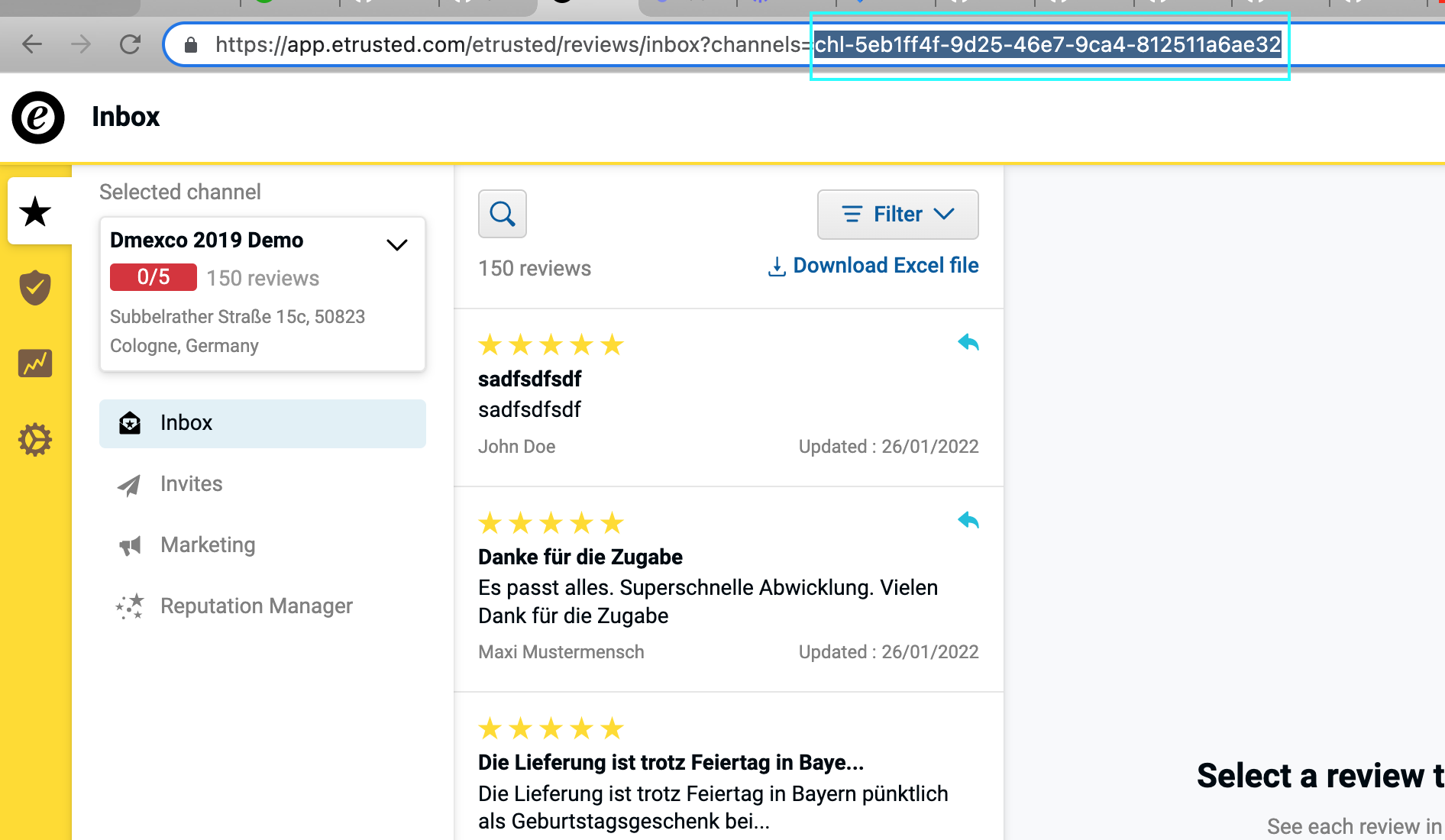Android Trustbadge Library
Show the Trustmark and the Shop Grade widget in your Android app in a few steps
This project is currently rapidly evolving and will likely recieve breaking changes.
Getting Started
Show the Trustmark and the Shop Grade widget in your Android app.
The Trustmark widget shows the validity of your trust certificate by Trusted Shop:

For expired certificates, the Trustmark widget will be presented as follows:

The ShopGrade widget expands to show shop rating and status with a simple animation. Currently, the widget shows the aggregate rating and the shop status.
In future, the widget will also show the shop reviews.

The ProductGrade widget expands to show product rating with a simple animation. Currently, the widget shows the single product rating for a given SKU (See the step: Implement the dependency).
In the future, the widget will also show the product reviews.

The BuyerProtection widget shows the amount of protection for the consumers' purchase. It can be shown in the checkout screen for that purpose.

Usage
Requirements:
- Access to eTrusted Control Center
- Your
channelIdandTSID
For more info about how to getchannelIdandTSIDread the Getting thechannelIdandTSIDsections (last section in this document).
You can add the Trustbadge widget to your Android project in 2 steps:
1. Implement the dependency
- In your
appmodule'sbuild.gradlefile, add the following line in your dependencies block:
dependencies {
implementation("com.etrusted.android.trustbadge.library:(version))")
}
- replace (version) with the latest version of the library. (See the releases page).
- Sync the project and make sure it is successful. If it is not, please make sure that the configuration file is placed under project root directory (e.g. not inside the
appmodule's directory)
2.Show the widget:
We recommend using Jetpack Compose to show the widget in your app.
Jetpack Compose Sample (Fastest):
Use the Trustbadge Compose function anywhere in your composables:
Example of showing the ShopGrade widget:
Trustbadge(
badgeContext = TrustbadgeContext.ShopGrade,
tsid = "X330A2E7D449E31E467D2F53A55DDD070",
channelId = "chl-b309535d-baa0-40df-a977-0b375379a3cc"
)

For ProductGrade, it is required to provide the product sku as well, that way the widget shows the rating for a product with given sku:
Trustbadge(
badgeContext = TrustbadgeContext.ProductGrade(sku = "1234-Ti-Bl"),
tsid = "X330A2E7D449E31E467D2F53A55DDD070",
channelId = "chl-b309535d-baa0-40df-a977-0b375379a3cc"
)

Showing BuyerProtection widget, is also similar to the ShopGrade:
Trustbadge(
badgeContext = TrustbadgeContext.BuyerProtection,
tsid = "X330A2E7D449E31E467D2F53A55DDD070",
channelId = "chl-b309535d-baa0-40df-a977-0b375379a3cc"
)

Align the badge anywhere in its parent using a standard Modifier. For example:
Trustbadge(
modifier = Modifier.align(Alignment.BottomStart),
badgeContext = TrustbadgeContext.ShopGrade,
tsid = "X330A2E7D449E31E467D2F53A55DDD070",
channelId = "chl-b309535d-baa0-40df-a977-0b375379a3cc"
)
Control hiding or showing the badge using the TrustbadgeState:
val badgeState = rememberTrustbadgeState()
Trustbadge(
state = badgeState,
badgeContext = TrustbadgeContext.ShopGrade,
tsid = "X330A2E7D449E31E467D2F53A55DDD070",
channelId = "chl-b309535d-baa0-40df-a977-0b375379a3cc"
)
// then badgeState can be used in desired events
LaunchedEffect(null) {
// show the badge
badgeState.show()
// hide the badge
badgeState.hide()
}
For example, hide the badge when the user scrolls using the badge state and scroll state of a column:
@Composable
internal fun HideBadgeOnScroll(
scrollState: ScrollState,
badgeState: TrustbadgeState
) {
if (scrollState.value == 0) {
badgeState.show()
} else {
LaunchedEffect(null) {
delay(1000)
badgeState.hide()
}
}
}

For full example of hiding the badge when the user scrolls, see HomeScreen.kt in the example app.
Legacy XML Sample (Requires more configuration):
Using the Legacy UI system requires more steps to show the widget:
First, add a ComposeView tag in your layout's XML file, for example:
<?xml version="1.0" encoding="utf-8"?>
<LinearLayout
xmlns:android="http://schemas.android.com/apk/res/android"
android:orientation="vertical"
android:layout_width="match_parent"
android:layout_height="match_parent">
<androidx.compose.ui.platform.ComposeView
android:id="@+id/compose_view"
android:layout_width="match_parent"
android:layout_height="match_parent" />
</LinearLayout>
Then in your source file, inflate the layout and get the ComposeView using the XML ID, set a composition strategy that works best for you and call the setContent() to use Compose.
Example of loading the Trustbadge in a fragment:
override fun onCreateView(
inflater: LayoutInflater,
container: ViewGroup?,
savedInstanceState: Bundle?
): View {
_binding = FragmentExampleBinding.inflate(inflater, container, false)
val view = binding.root
binding.composeView.apply {
// Dispose of the Composition when the view's LifecycleOwner
// is destroyed
setViewCompositionStrategy(ViewCompositionStrategy.DisposeOnViewTreeLifecycleDestroyed)
setContent {
// In Compose world
Trustbadge(
badgeContext = TrustbadgeContext.ShopGrade,
tsid = "X330A2E7D449E31E467D2F53A55DDD070",
channelId = "chl-b309535d-baa0-40df-a977-0b375379a3cc"
)
}
}
return view
}
For more information about Compose interoperability with the legacy system, please refer to Android official docs for Interoperability APIs.
Dark Mode
The Trustbadge Widget now supports Dark Mode on Android.
By default, the widget will follow the system theme.

To override the system theme, you can force the widget to use Dark Mode by wrapping the Trustbadge composable in a TrustbadgeTheme and setting the darkTheme parameter to true in the TrustbadgeTheme.
Example of overriding the system theme to Dark Mode:
TrustbadgeTheme(darkTheme = true) {
Trustbadge(...)
}
For more information about forcing Dark Mode, please refer to Android official docs for Force Dark.
Your eTrusted account might contain more than one channel. The Trustbadge function requires a channelId to determine which channel it should choose to load the information from your account.
Please read the section Getting channelId and TSID for more information about how to get that information.
The Trustbadge function requires a badgeContext to determine either showing the TrustMark, the ShopGrade, or the BuyerProtection widget.
You can simply pass either of the following options to set your desired badgeContext:
- TrustbadgeContext.TrustMark
- TrustbadgeContext.ShopGrade
- TrustbadgeContext.ProductGrade
- TrustbadgeContext.BuyerProtection
Getting channelId and TSID
channelId and TSIDStep 1:
You can find your channelId by navigating to your desired channel on eTrustd Control Center in your browser. You can simply copy the channelId from the address bar (starts with chl-) for your desired channel as shown in the example image:

Step 2:
If you don't have a TSID (usually shared during the onboarding process with Trusted Shops), You can get your TSID by contacting Trsuted Shop via email: [email protected]
Support
Please let us know if you have suggestions or questions. You may also contact Trusted Shop's mobile engineering team via email: [email protected]
Updated over 2 years ago
